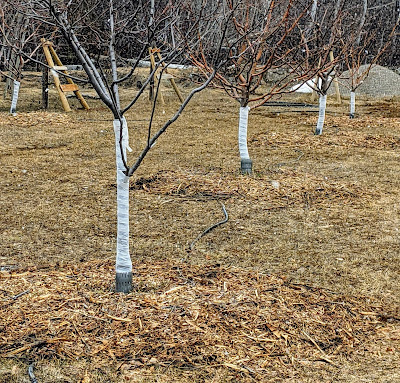Never Water Your Fruit Trees Again?
I often get questions like, "How often should I water my fruit trees?" Fruit trees need lots of water to grow and produce fruit, but the amount of water needed really depends on where you live. Relative humidity, temperature, wind, precipitation, slope, and soil type will all play a part in how often you water your trees. Too much water can cause problems like root rot and other soil born pathogens. Standing water on leaves can cause fungal diseases like powdery mildew.
There are complex calculations like the one below that can be used to determine the optimal watering schedule. These formulas take many of the above mentioned factors into play, but unless you like to geek out on Math and Physics, I would like to propose a much simpler solution that will not only help your trees get the water they need, but will also give your trees nutrients and reduce weed and pest pressure.
 |
| Image used from: study.com |
This year I watered my trees zero times. Yes, not even once and this was an unusually hot dry summer. At one point I was about to turn the water on, but a nice rain came just in time and did it for me. I understand that this is not always possible in every environment, but taking the guess work out of the complexities of watering your trees is possible.
When snow melts in the spring the soil reaches field capacity and the mulch acts like a sponge and increases the amount of moisture in and around the tree. As spring turns to summer, the soil begins to dry, but the area around the tree is shaded and protected by the wood mulch. When the moisture in the mulch begins to evaporate, it keeps the soil underneath cool and moist. Eventually the soil will dry out, but every time it rains in the summer the sponge fills back up and the soil remains moist, but not too wet.
In addition to keeping the soil cool and moist, the mulch is constantly being broken down by bugs, worms, and fungi. As these organisms break down the mulch, they are releasing important nutrients that help feed the soil which ultimately feeds the tree. This doesn't happen all at once, but slowly and consistently, just the way tree's like it.
On occasion I will find a dandelion or orchard grass growing up through the mulch, but I just bury it with more mulch. Because of the complex ecosystem of beneficial insects and fungi, I don't worry about any one pest getting a strong hold and turning into an infestation.
A thick layer of wood mulch under your trees that extends out past the drip line of your tree, will help retain water, improve soil, feed your tree, and reduce weed and pest pressure. That all sounds pretty good right!?
How do you know if and when your tree needs water? Well, you just dig down to the soil and check. When the soil under the mulch feels dry, give your tree a long, slow soak. Longer, less frequent watering will decrease the amount of dissolved minerals in your soil and allow your trees to access the moisture they need.
Thanks for Reading! If you would like to learn more about the care and pruning of fruit trees, please browse our 100+ fruit tree articles here, join our Backyard Fruit Growers Facebook Group, and take our free Fruit Tree Pruning Course. Also, please subscribe to our Fruit Pruning YouTube Channel.








I am not sure if that is wise: Because I prune trees and shrubs professionally, I'm able to chip and shred all of the leaves, branches, and other yard waste and spread it around my trees.""
ReplyDeleteThe problem is it seems to be a good was to introduce insects, disease, and pesticides& other chemicals to your orchard.
We have very low pest pressure even with imported tree materials. As a matter if fact we see a huge improvement in overall tree health that is directly related to the mulch rings around the trees.
DeleteI totally agree with the use of mega-mulch of the free variety. The soil is nearly always moist under the mulch. If a week does grow in the mulch, it is only rooted in the mulch and is easy to pull. No mower or weed whip damage to the bark. Easy to mow around. Soft cushion for fruits to fall onto. Easy to find fruits and nuts on top of the mulch.
DeleteThank you for your comment. I have noticed all of those benefits too.
DeleteBuilding Healthy Soil > Watering
ReplyDeleteI run an urban tree nursery in Edmonton and rarely water. Healthy soil is key. I bring in truckloads of mulch, spread it around the nursery, and inoculated with indigenous micro-organism.
Yeah, I would be interested in you inoculation process.
DeleteI too do not water my trees. However I NEVER use trimmings and leaves as mulch as this is a way to very likely spread bugs and disease to trees or plants. From the vere start at planting, I insert a pvc drain pipe in the hole in which the tree is planted. This where I insert my hose and inject water into the ground.
ReplyDeleteThe benefits to shredded tree mulch outweighs the risk of spreading disease. Shredding eliminates the insects, and the mulch on the surface is bombarded by UV, which eliminates the majority of the contagious diseases that could inoculate your tree. Lastly, the decomposition of organic matter breeds beneficial microbiology which also eliminates pest and disease pressure. The mulch never makes contact with the tree and only touches the surface of the soil around the tree.
Delete